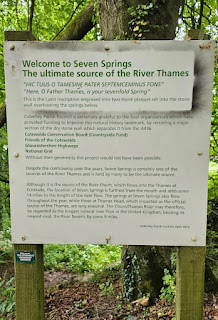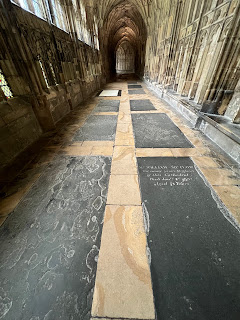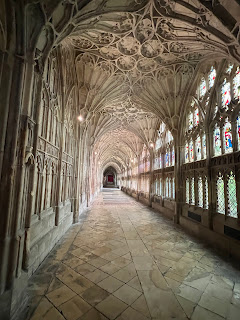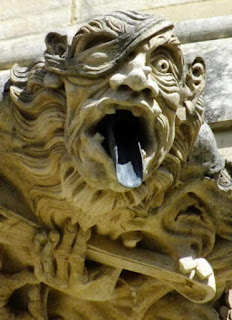Cotswolds - Day 1 - Birdlip
The breakfast room
After completely unpacking and repacking our bags, packing up our backpacks, and hauling our heavy suitcases down three flights of stairs, we were ready for our breakfast.
After completely unpacking and repacking our bags, packing up our backpacks, and hauling our heavy suitcases down three flights of stairs, we were ready for our breakfast.
And a fruit salad starter
Jo Anne had yogurt, granola, fruit and a croissant.
After breakfast we called for a taxi to take us to the start of the walk. Just as the driver pulled out of sight, I realized my hiking poles were still in the taxi. I immediately called the hotel who had arranged the taxi to see if she could reach him to turn around but it was too late. The plan was for him to take them back to the hotel and maybe they would get there in time to travel with my bag. Apparently they did because they were with my bag when we arrived at our next destination. Yay! God is so good!
One detail about the Cotswold Way is that since it stretches so far, different folks manage the signage and it is not all uniform. The trail is very well-marked, but the markings aren’t always the same color, AND there are some other trails that are easy to confuse with The Cotswold Way, such as The Cotswold Way Circular Walk. Therefore, it is imperative to read the trail markers carefully.
We picked up the trail at Seven Springs which is mostly a rather busy, noisy roundabout, and many think it's a contender for the least attractive part of the entire trail. However, it does boast one rather important distinction. It is considered by many to be the source of the River Thames, identified by John Leland in 1546.
On the opposite side of the A436, there are seven small trickles of water dropping down a mossy wall into a pool. If you look closely at the stonework, you'll see a carving in the stone that reads, 'Hic tuus o Tamesine Pater septemceminus fons', which translates, 'Here, O Father Thames, is your sevenfold spring'. Water from these springs combines to form a small river called the Churn, which in turn, feeds the Thames.
Our first signs on the trail.
It is just so incredibly beautiful.
I guess Jo Anne took a pic of her pack and poles 😁
The round sign says pray more worry less.
Jo Anne standing in one of her favorite things - a tree tunnel.
The city of Cheltenham, where we stayed last night.
We reached the highest point of the trail early in the day, then we had many ups and downs to follow.
An interesting hillfort welcomes us at Leckhampton Hill. Once inhabited by the Dubai tribe and built more than 2000 years ago. I love these trig points that show you where everything is around you.
Lekhampton hill also treated us to the magnificently imposing Devil’s Chimney a result of quarrying that happened between 1617 & 1926. This crooked and twisted chimney rising from the ground has given claim to a legend involving the Devil hurling stones from this spot at worshipers as they made their way to church on a Sunday.
Blue weed (yes, that's its name)
Climbing and climbing
Beautiful Horses
Holly
European dewberry
We stopped in for a break at the Star Bistro. When we walked in the door there was an older woman at the desk who said go right on in but no cake for you. Well they had gluten free ginger cake so we had some anyway 🤣
European smoketree
Always steps to climb
And some very wet and muddy places
So glad to see they were building a new dry stack wall just like the very old ones.
This was a nice little cafe up on the hill with toilets.
We pass a Neolithic settlement at Crickley Hill who were once among the earliest farmers in Britain, all while enjoying sunny views as far as the eye can see across Cheltenham and onto the Sugar loaf and Breacon Beacons in Wales.
Excavations managed by the Crickley Hill Archaeological Trust took place here each summer from 1969 - 1993. In that time more than a million finds were excavated and the remains of fortifications, settlements and sites of worship uncovered. They indicate that the Hill was inhabited at various times for about 4,500 years between 3700BC and AD500.
The main settlements were Neolithic. In addition a part of the site known as the "Long Mound" seems to have been used for ritual/religious purposes and included a Neolithic shrine, stone circle and processional way.
We pass fields of wild flowers, squirrels scampering from branch to branch, paddocks of horses and birds of all kinds. Speaking of birds, I forgot to mention there was a kestrel nesting in the bell tower at Lanercost Priory (Hadrians Wall). You could just see the tiny little babies peeking their heads above the nest. Way too far away to show in my phone camera.
This natural environment attracts a broad diversity of birds, butterflies and wild flowers, including the rare bee orchid. Sadly, we never saw the orchid.
After a steep and busy road, we come to the stone-built Royal George Hotel, an English country hotel, set on 26 acres, with views over the Gloucestershire countryside, and our lodging for tonight. I can’t tell you how unnerving it is to come into traffic areas like this after being out in the wild all day.
Mexican orange blossom
Daisy bush
There is nothing much in Birdlip so we grabbed a taxi to Gloucester to take a tour of the Cathedral.
Daisy bush
There is nothing much in Birdlip so we grabbed a taxi to Gloucester to take a tour of the Cathedral.
It was first founded by Anglo-Saxon prince, Osric, in 678 AD although little is known about its early days. It became a Norman Abbey after the conquest of 1066 and grew into a magnificent abbey, overseen by a monk named Serlo.
Major events during the Middle Ages include the crowning of Henry III and the burying of King Edward II.
When Henry VIII split from Rome in the 1500s, it became a Cathedral rather than Abbey. Then began the troubled days: in the 16th and 17th centuries, several bishops were burnt at the stake over differing views surrounding the country’s new religion (Church of England).
Since the 1700s, things have run more smoothly. The Cathedral is kept in traditional style and only repaired, not remodeled or modernized.
A new era began when audiences became fascinated by period dramas. Several TV shows have been filmed at Gloucester Cathedral including several of the Harry Potter movies.
Scenes from the Philosopher’s Stone (2001), Chamber of Secrets (2002) and the Half-Blood Prince (2009) were filmed at Gloucester Cathedral.
The Lavatorium is the North Corridor. The deep grooves of the sinks are quite distinctive. It was once a communal washing area for monks. When monks lived here, people did not wash very often. The monks only bathed 3 times a year but they did wash their hands daily in the lavatorium.
Although most visitors to the cathedral are there to snap photos of all the Harry Potter filming locations, I was there for the stained glass. There are thousands of stained glass windows. I only photographed a few.
This magnificent medieval window fills the Quire with light. Installed in the 1350s, it shows a hierarchy of noblemen’s coats of arms, kings, clergy and saints leading upwards towards Jesus and his mother Mary. Amazingly, most of the glass has survived for more than 650 years.
Incredible ceiling
Fun fact – the oldest existing images of golf can be found in the (much older) stained glass windows dating back to 1350. There’s also a carved statue of people playing medieval football.
The cloisters are indescribable.
All of these large slate tiles are “headstones” above graves.
This space is known as the Slype, and was the link between the monastery and the outside world. Here, deliveries of food and beer were made and monks could meet their friends and family.
All of these large slate tiles are “headstones” above graves.
This space is known as the Slype, and was the link between the monastery and the outside world. Here, deliveries of food and beer were made and monks could meet their friends and family.
This ceiling is called a fan-vaulting and it was invented here in the 1350s. It is copied in churches all over the country.
More headstones
A church within a church. This is the heart of the cathedral where worship is focused around the High Altar. Christians have worshipped here every day for more than 900 years. The decorated floor tiles date back to the 1450s but they were relaid in the 1870s. The tiles are arranged in 4, 9, or 16 to form larger patterns, some including Latin inscriptions suggesting that learned monks may have helped design them.
These are storage chests for valuable robes ( ceremonial robes) worn by medieval abbots. They were made on the 1350s.
John Bower had 9 sons and seven daughters by his wife Anne Bower. This is a painting of the family.
Here are some doors for you Cathie.
I recently learned that statues are only gargoyles if they have a water spout. Otherwise, they’re ‘grotesques’. Dotted around the outside of Gloucester Cathedral are countless gargoyles and grotesques.
Here are some closeup photos of them. (Not my photos)
Although they’re hard to see from the ground, they all have so much character, but whether they have a water spout or not, they are all grotesque in my opinion.
After touring the cathedral, we went for dinner at Rene’s Cafe.
I had a burger with salad and fries.
Jo Anne had bourbon glazed sticky belly pork bites with chips.
This was a cute little brooms and brushes shop.
Gloucester city centre
Our room and the view from our room.
Stats
Steps - 29,832
Miles - 13
Elev gain - 912’ or 34 floors
I've been listening to a series of messages from Sinclair Ferguson titled "Sojourners and Exiles" (imagine that 😊) the message of First Peter. To summarize a bit: it is not strange for Christians to find ourselves marginalized by society. We do not belong here. We are sojourners and exiles whose true home is in heaven. This heavenly citizenship gives us our identity, our hope, and our guidance regarding how to live.
































































































































Carol just remarked she forgot to mention that we completed our walk and arrived at our Inn at 1:45, taking us only 4 hours, which was the estimated time. However, because I have done zero training for this, I was expecting a good 6 hours. I was pleased with our time. Carol would have done it faster without me, but I did a pretty good job keeping up. I survived. We’ll see how I feel in the morning 🥴
ReplyDeleteI loved all the tunnels of trees we went through. I’m not sure what it is about them that I find so appealing.
The Gloucester Cathedral was amazing. The pictures just don’t do it justice.
All in all it was a good day.
I’m so proud of you and thankful I can experience this through you!lol
DeleteLike you, the tunnels of trees would be my favorite. Be safe! Joy
The Gloucester Cathedral was so beautiful! I can only imagine how stunning it was in person. Wow. The wild flowers were beautiful as well. Thank you for sharing. You ladies are amazing. Liz
ReplyDeleteCarol, you did it without your walking sticks! Awesome. Your hand must be doing great. All the stain glass was amazing.
ReplyDeleteStay safe
Vicki
Another amazing leg of your “walk”. I just want to know when you are going to start the training class to those that wish to tag along with you on your next “walk”.
ReplyDeleteThank you so much for sharing this, truly!! ❤️
Connie FBC
I agree with Connie! Such an amazing walk. Thank you so much for sharing your great adventure with us! Michelle FBC
ReplyDeleteOh my goodness! Incredible beauty, flowers, scenery, architecture ! But the Gloucester Cathedral is too amazing to even describe. The sculpted wall with the glorious stained glass just wow!! Great job Jo Anne and Carol on good stats today. ~Much love, Kody
ReplyDelete